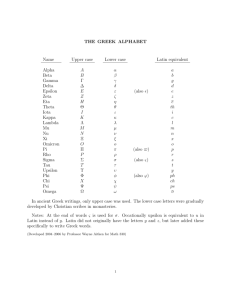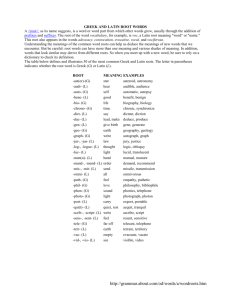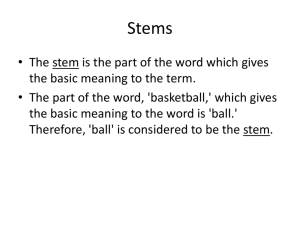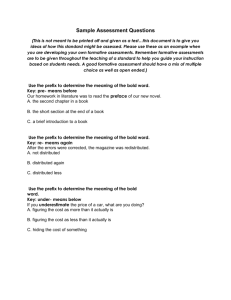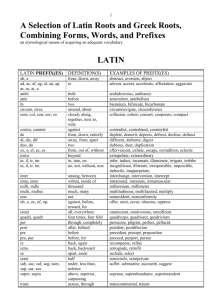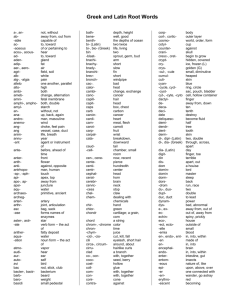Introduction and Definitions
advertisement
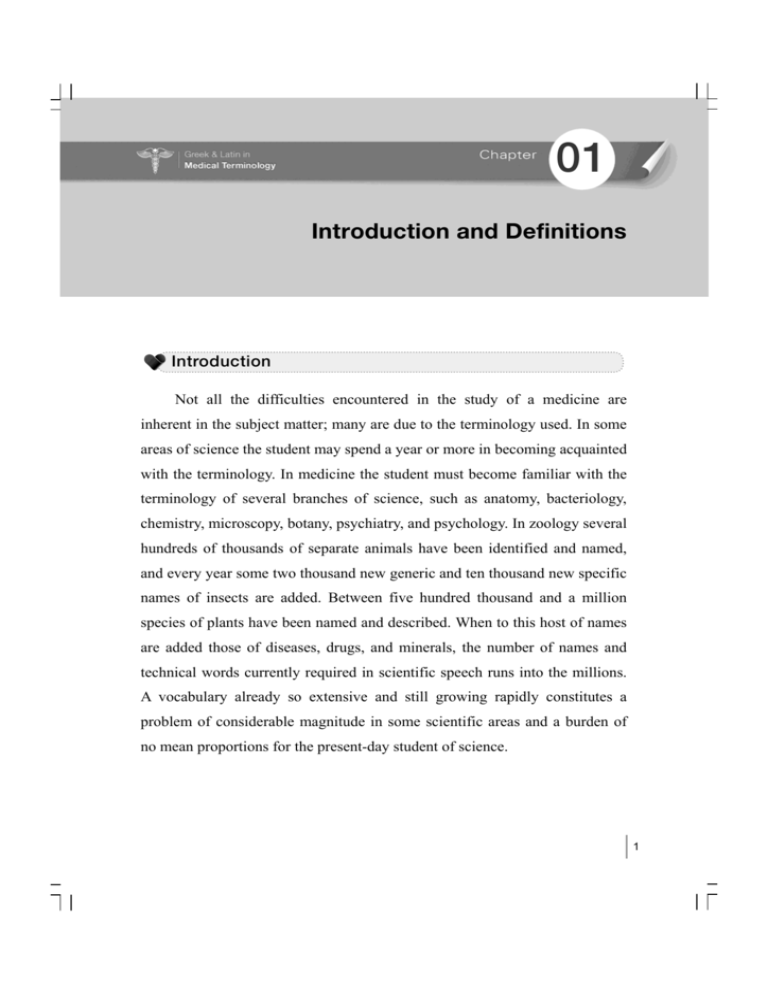
01 Introduction and Definitions Introduction Not all the difficulties encountered in the study of a medicine are inherent in the subject matter; many are due to the terminology used. In some areas of science the student may spend a year or more in becoming acquainted with the terminology. In medicine the student must become familiar with the terminology of several branches of science, such as anatomy, bacteriology, chemistry, microscopy, botany, psychiatry, and psychology. In zoology several hundreds of thousands of separate animals have been identified and named, and every year some two thousand new generic and ten thousand new specific names of insects are added. Between five hundred thousand and a million species of plants have been named and described. When to this host of names are added those of diseases, drugs, and minerals, the number of names and technical words currently required in scientific speech runs into the millions. A vocabulary already so extensive and still growing rapidly constitutes a problem of considerable magnitude in some scientific areas and a burden of no mean proportions for the present-day student of science. 1 The purpose of this book is to furnish information and material which will aid in reducing the vocabulary burden for the student of biology and medicine. Its twofold objective is (1) to increase the student’s facility in determining the meaning of scientific words by analyzing their structure, and (2) to encourage the student to establish sound nomenclatural criteria for himself and his profession. The nature and the scope of this book’s contents have been largely determined by the fact that the ancient Greek and Latin languages underlie both the structure and the meaning of most of the technical name and terms used in biology and medicine. Moreover, all scientific names of plants, bacteria, and animals have been Latinized and are therefore, in effect, Latin words whose structure, inflection, and syntax are governed by the rules of classical Latin. For these reasons, only Greek and Latin words and scientific names and terms derived from them have been included in the word lists and, with few exceptions, the words used for illustrative purposes throughout the book are words of Greek or Latin origin. Of the numerous principles of word formation and inflection in the Greek and Latin languages, however, only those have been outlined in these texts which have had the most direct and extensive application to the construction and the form of modern biological names and terms. In order to attain its primary objective, and in order to meet the student’s most immediate and practical need, this book seeks above all else to provide in ample quantity the kind of material necessary for learning those Greek and Latin roots, stems, and affixes which recur most often in the technical terms 2 Chapter 1 Introduction and Definitions of medicine and biology. These essential working materials are furnished in several word lists which contain the Greek and Latin source words and samples of modern scientific names and terms derived from them. In seeking to achieve its secondary objective, the book contains discussions on certain aspects of biological nomenclature which relate directly or indirectly to the origin and the structure of technical terms. Some of the affiliated topics discussed are synonymy, hybrid terms, and international codes of nomenclature, eponyms, and pronunciation. If students at an early stage in their studies acquire an awareness of past and present usages in scientific nomenclature and an appreciation of what are desirable practices in the formation of scientific terms, it can reasonably be hoped that in time there will be general agreement among scientists about what constitutes sound onomatological practices. The happy result will be that word coinages will rarely result in haphazard terms to add weight to an already heavy burden, but will instead be distinguished memorials to scientists who believed that the name applied to a disease, treatment, drugs, plant, or animal should be a help rather than a hindrance to clear and effective communication of ideas. 3 Definitions of Some Frequently Used Terms Throughout the discussions in this book certain terms are used repeatedly. In order that these terms may be fully understood whenever they appear, the following definitions and illustrations of them are given: ◇ Root A root is that primitive and fundamental verbal element which expresses the basic meaning or suggestion that is common to all the words of a related group; it is the core from which several differentiated words (e.g., nouns, verb, adjectives, and adverbs) spring up by the addition of formative elements such as prefixes, infixes, and suffixes. Gen- (Greek= gignesthai; Latin= gignere): come into being, become, be born. gene genus genesis generation exogenous autogeny oxygen Spec- (Lat. spectare or –specere): see, look at, spy. 4 species specific specialist spectrum perspective speculum specimen Chapter 1 Introduction and Definitions Sta- (Gk. histanai; Lat. stare): set, stand. status static stable instability hypostasis ◇ Stem The stem is that part of a word to which inflectional endings are attached. Because of morphological and phonetic changes (e.g., elision, assimilation) that take place when inflectional endings are added, the stem of a Greek or Latin word is not always apparent in the form of the word that is first presented by a dictionary or textbook. Word Stem Meaning alga alga- seaweed fungus fungo- fungus soma somat- body helmins helminth- worm genos genes- birth lithos litho- stone Some stems are separable; that is, they may be used alone or in combination with other stems, prefixes, or suffixes. 5 Word Stem Meaning Example askos asko- bag, sack ascocarp ergon ergo- work asynergia Some stems are separable; that is, they always appear in combination with other stems and are never used alone, even though they may have independent meanings. Word Stem Meaning Example algos alges- pain algesthesia, cardialgia jectum jecto- throw injection, trajection ◇ Base The terms base and stem are often used synonymously. Linguistically, however, only stem has validity. But base is a convenient designation for that part of an inflected word which remains unchanged so that, even though it has no scientific linguistic value, base dose have a practical value in simplifying explanations of word construction. In the examples below, it will be noted that the base and the stem of a word may be alike but that more often they differ in that the stem ends in a vowel and the base ends in a consonant. 6 Chapter 1 Introduction and Definitions Greek or Meaning Stem Base Latin Word mensa, Using Base table mensa- mens- ensae lac, lactis Derivatives mensal, commensal, milk lact- lact- lactary, lactiferous, ablactation kyklos, circle kyklo- kykl- kyklou sarx, sarkos cyclostomate, heterocyclic flesh sark- sark- entosarc, sarcohydrocele scribere, write scriptum scribe- scrib- prescribe, scripto- script- nondescript, superscription facere, factum make, do face- facie- calorifacient, facto- fact- factor ◇ Prefix A prefix is an element attached to the beginning of a root, stem, or base. Its function is to elaborate, qualify, or intensify the meaning of a word. It consists of one or more syllables and is generally derived from a preposition or an adverb. 7 Prefix Meaning In Compound Latin or Word Greek Meaning trans across transocular oculus eye per through permeate meare to go hyper over hypertrophy trophe nourishment ento within entophyte phyton plant The term prefix should not be applied to noun, verb, or adjective stems which are used as the first component of compound words; in “laterocervical” (latus, lateris = side), for example, latero- is not a prefix even though it is “prefixed” to another word. Dys- = bad, painful, difficult, abnormal ex. Dysfunction dyspepsia dyspepsodynia dysphagia Endo- = within ex. Endocrine glands Exo- = outside ex. Exocrine glands Hyper- = excessive, more than normal ex. Hyperglycemia hypertension 8 Chapter 1 Introduction and Definitions Hypo- = below, less than normal ex. Hypoglycemia hypotension ◇ Suffix A suffix is an element of one or more syllables attached to the end of a root, stem, or base. In addition to contributing its own particular meaning to a word, a suffix may also indicate part of speech, gender, case, number, person, tense, mood, or voice. Stem or Base Meaning Suffix Meaning Word flex- bend -or that which flexor sanat- heal -orium place where sanatorium steno- narrow -sis condition of stenosis enter- intestine -itis inflammation enteritis -algia = pain ex. Arthragia -cyte = cell ex. Leukocyte -ectomy = removal, excision ex. Gastrectomy -emia = blood ex. Leukemia -itis = inflammation ex. Gastroenteritis -oma = tumor, mass ex. Hepatoma -osis = abnormal condition ex. Nephrosis 9 ◇ Combining Vowel & Combining Form A combining vowel is used between constructive units of a compound word in order to join them euphoniously. The vowels most commonly used are o and i, although the other vowels also occur. hydr- (water) + phob- (fear) = hydrophobia anthrop- (man) + metr- (measure) = anthropometry arch- (main) + blast- (germ cell) = archiblast cervic- (neck) + faci- (face) = cervicofacial flav- (yellow) + bacteri- (bacteria) = flavobacterium A combining vowel is ordinarily not used when the second constructive member of a compound word begins with a vowel or a diphthong. mes- (middle) noct- (night) + enter- (intestine) = mesenteron + odont- (tooth) = mesodont + ambulat- (stroll) = noctambulation In some words, however, a combining vowel has been used even if the second member begins with a vowel. 10

